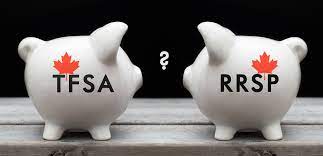When it comes to saving for retirement, there are two popular tax-advantaged accounts in Canada – Registered Retirement Savings Plans (RRSPs) and Tax-Free Savings Accounts (TFSAs). Both have their pros and cons, and it can be challenging to determine which one is right for you.
In this article, we’ll compare RRSPs and TFSAs, their benefits, drawbacks, and help you decide which one to choose.

What is an RRSP?
RRSPs are a type of investment account that allows you to save money for your retirement. They offer a tax deduction on contributions made and tax-deferred growth on your investments. You can contribute to your RRSP up to 18% of your earned income, and The RRSP contribution limit for 2023 is $30,780.
You can check your RRSP limit here.
Pros of RRSPs:
- Tax-deductible contributions: RRSP contributions are tax-deductible, which means that you can reduce your taxable income and get a tax refund.
- Tax-deferred growth: Your investments grow tax-free until you withdraw them, which can help to compound your returns over time.
- Lower tax rate in retirement: You will likely be in a lower tax bracket in retirement than when you were working, which can reduce your tax bill when you withdraw funds from your RRSP.
Cons of RRSPs:
1) Taxes on withdrawals: When you withdraw funds from your RRSP, you will need to pay taxes on the amount withdrawn. This can be a disadvantage if you are in a higher tax bracket in retirement.
2) Mandatory withdrawals: Once you turn 71, you are required to withdraw a minimum amount from your RRSP each year. This can limit your flexibility in retirement and increase your taxable income.
What is a TFSA?
TFSAs are a type of investment account that allows you to save money tax-free. You can contribute up to $6,000 per year to your TFSA, and there is no maximum contribution limit.
You can check your TFSA contribution Room Here.
Pros of TFSAs:
1) Tax-free growth: Your investments grow tax-free, which means that you do not need to pay taxes on any capital gains, dividends, or interest earned.
2) No taxes on withdrawals: When you withdraw funds from your TFSA, you do not need to pay taxes on the amount withdrawn.
3) Flexibility: You can withdraw money from your TFSA at any time without penalty, and there are no mandatory withdrawals.
Cons of TFSAs:
1) No tax deduction on contributions: You cannot deduct contributions made to your TFSA from your taxable income.
2) Contribution limits: There are annual contribution limits to TFSAs, which may limit how much you can save for retirement.
Wealthsimple is one the most popular canadian company that allow you to invest, trade or save with 0% commission rate. You can check their full detail here.
Fund a DIY trading or a managed investing account and get between $5 and $3,000 in cash to invest.
Which one should you choose?
The choice between an RRSP and a TFSA depends on your individual circumstances, financial goals, and tax situation. If you expect to be in a higher tax bracket in retirement than you are now, an RRSP may be the better choice. On the other hand, you expect to be in a lower tax bracket or are unsure, a TFSA may be the better choice. If you have already maxed out your RRSP contributions, a TFSA can be a good way to supplement your retirement savings.
Alternatively, if you are in a lower tax bracket now, you may want to prioritize contributing to a TFSA first and then an RRSP later.
Conclusion: RRSPs and TFSAs are both valuable tools for saving for retirement. RRSPs offer a tax deduction on contributions and tax-deferred growth, while TFSAs offer tax-free growth and flexibility. The choice between the two depends on your individual circumstances and financial goals. Consider speaking with a financial advisor to help you decide which one is best for you

